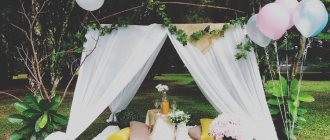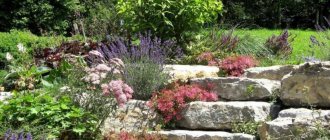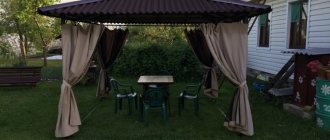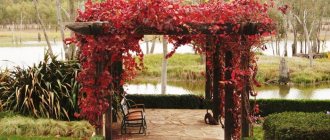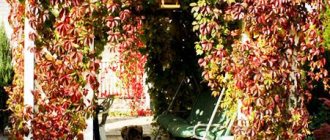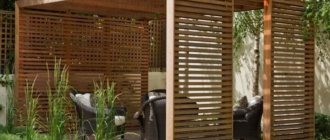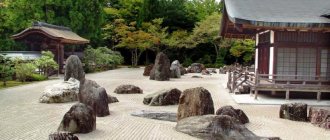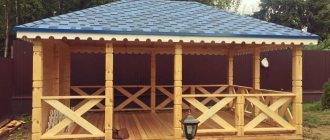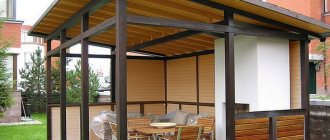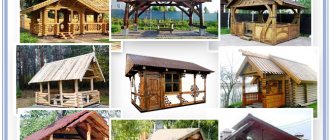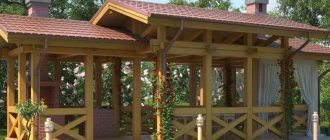- Video: how to sew an awning roof on a gazebo tent
- Advantages of an awning gazebo
- How to choose an awning for a tent
- How to set up a tent
- DIY awning with wooden frame
- Other options
- Is it possible to sew an awning yourself?
- PVC awning repair
The awning gazebo-tent is functional, practical and easy to use. It is advisable to use it when there is no possibility or need to build a permanent permanent tent on a certain site somewhere on the river bank or in a country house. One of the main advantages of such a gazebo is the ease of assembly and disassembly - to completely equip it on the ground, just 20-30 minutes is enough. Due to its light weight, it is easy to carry from one place to another. Depending on your needs and capabilities, you can purchase an awning tent for a gazebo , taking into account a specific size, type of structure and color.
Tent tent for gazebo.
Typically, such gazebos are installed for the spring-autumn period; at the end of the warm season, the awning is rolled up, the frame is disassembled, and the compact structure is sent for storage to any utility room.
Advantages of an awning gazebo
The gazebo tent has a number of advantages that make such a product an indispensable assistant when relaxing outdoors or in the countryside. If necessary, it can be quickly expanded and rolled up, spending a minimum of effort and time. Thanks to its compactness, there are no problems when transporting the tent - when folded, it takes up little space in the trunk or inside the car. It can be stored on the balcony, warehouse and utility room. Tent gazebos, made from high-quality materials, are excellent protection from bad weather - ultraviolet rays, rain, wind and insects.
Manufacturers make tent gazebos of different sizes, from small to large. Small tents are designed for 1-2 people, and spacious ones can accommodate up to 8 people. A separate category includes tourist gazebos, which are characterized by a reliable fastening system and the strength of the material, coated with protective solutions against moisture and elevated temperatures.
What material would be better for the frame?
Choosing a cover for a gazebo tent is another half of the problem. It is much more important to properly purchase a high-quality frame that can withstand not only the weight of the coating, but also additional loads in the form of wind and rain.
Fiberglass
The cheapest material used for budget tents. The thickness of the tubes and arcs will play a decisive role: preference will need to be given to thick ones.
You shouldn’t rely on durability and reliability; when purchasing such a frame, be prepared for it to break. It is not suitable for serious purchases.
Duralumin
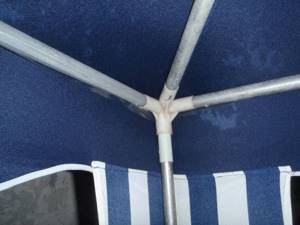
Lightweight and easy to use, duralumin perfect as a frame material for your gazebo-tent. An unpleasant quality of this material is its fragility - if the metal is bent too much, then it can burst.
If you don’t delve into alloy numbers and their qualities, then take something that is a little more expensive and more aesthetically pleasing. In most cases, you won't go wrong if you overpay 5-10% of the original option.
Steel
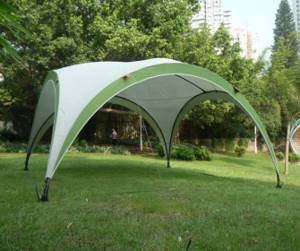
The relatively heavy and extremely durable frame will be made of steel. Thanks to the performance characteristics of the metal frame, your tent will “stand firmly on its feet.” The only thing you will periodically think about is rust and corrosion of the metal - it will need to be processed periodically.
The steel frame is the most expensive and high-quality in the context of gazebo-tents. The more massive the steel, the stronger the gazebo will be installed.
How to choose an awning for a tent
The convenience of using the tent tent in the future depends on the correct choice. First of all, you should determine how many people will be accommodated in the gazebo, and what purpose it will have. For example, for outdoor recreation in a small company, a gazebo with dimensions of 3x3 meters is ideal. And if, in addition to guests, you plan to shelter the car from precipitation, then a tent 5-6 meters long is needed.
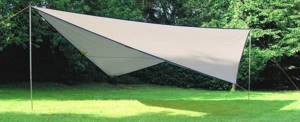
The most practical feature is a special fabric that can fully protect the space inside the gazebo from rain and wind.
It is also important to pay attention to the type of frame, which can be plastic, wood or metal. Sometimes there are combined frames, with a combination of several types of building materials, for example wood and metal.
Wooden frame - most often made in the style of lattice posts, which makes it visually attractive. Such gazebos are more expensive than those with metal and plastic frames. The plastic frame does not have sufficient strength, which is why it is used only in the production of small tents with a capacity of 1-2 people. With a larger tent capacity, gusts of wind can cause the frame to break. The metal frame is very strong and reliable, as it is made of steel pipes treated with a powder composition. Heavy weight is the only drawback of this base.
Thanks to the stands and stands attached to them, the gazebo-tent can be installed on a solid area, either stuck into the ground with pins or simply placed on the base. Additionally, the tent is reinforced with rods, which are located at the bottom of the frame. Depending on the design of the frame, the gazebo can have the shape of a polyhedron, square, circle or rectangle. A rectangular gazebo is more resistant to gusts of wind.
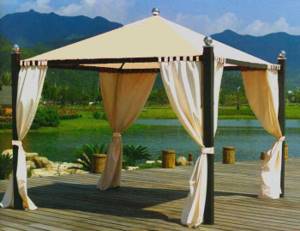
Tent tent for gazebo.
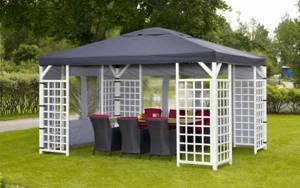
The size of the gazebo with awning is selected depending on the purpose of use.
Gazebos-tents also differ in the degree of transparency of the material, which, accordingly, can consist of either a transparent or non-transparent awning. In this case, the choice depends on how much sunlight you prefer to have indoors. You can even opt for a combined option, with transparent inserts in the main material that will serve as windows.
Tents can also be equipped with a mosquito net instead of one or more walls, which can be fastened with zippers, Velcro and buttons. In some models, there are sealed strips along the edges of such meshes that prevent moisture from penetrating into the room. Sometimes a mosquito net comes separately with the tent, which can be installed if necessary.
There are open-type gazebo-tents that have only roofs without walls, essentially being a canopy. In the production of awning tents, PVC or tarpaulin are used - durable materials impregnated with protective compounds.
Many closed gazebos can be turned into open ones - just unfasten the walls and lift them to the top of the structure, which will ensure air ventilation in the room.
There are also gazebos made entirely of transparent material, which, in addition to transmitting sunlight, are effective protection from rain. Transparent tents are also sometimes used as shelter for plants in the garden to protect them from gusts of wind, rain and frost.
There are expensive options for gazebo-tents, which can be used not only for outdoor recreation, but also for organizing public facilities - they can serve as a pavilion, cafe, or retail outlet.
Such tents are distinguished by their attractive appearance and long service life. Their cost varies within tens of thousands of rubles. By comparison, the cost of gazebo-canopies is 2000–3000 rubles. The price of closed-type tents, with a metal base and removable walls, is estimated at 4000-5000 rubles.
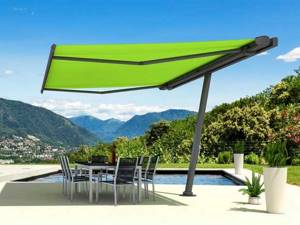
There are other options for canopies, when only the roof needs to be sewn from thick fabric.

Gazebos with an awning cover can withstand temperature fluctuations from -30° to +60°C.
Tourist-type gazebos, unlike other options, are more durable, as they have a more durable structure that is designed to withstand heavy loads - strong gusts of wind and an abundance of precipitation are not a problem for them. The material of tourist tents is covered with a water- and fire-resistant composition, which means that sparks from a fire, rain, and sun rays are not afraid of it. They also have mosquito nets to protect against insects and ties that greatly facilitate the installation process. Tourist gazebos are more expensive than regular options.
Pavilions are suitable for organizing various events. Their main difference from ordinary tents is their large size. They can accommodate a large number of people.
Awning tents are sold at retail outlets with goods for the garden and garden - in supermarkets, shops, at the market, on the way to the dacha. However, in order to purchase a high-quality gazebo, you should take its choice seriously - pay attention to the quality of the material and components that are specified in the product instructions.
Disadvantages of a wedding tent
- The cost of renting a wedding tent and equipment for it can reach a significant amount. The price largely depends on the quality and design of the product.
- Significant additional costs will be required to organize a comfortable space inside. For example, this could include installing heat guns in case of cold weather or air conditioners for the hot season. It is also worth remembering that the wedding tent is placed directly on the ground. If women wearing high-heeled shoes take part in the event, then you should think about installing wooden flooring, which will greatly facilitate movement.
- Electricity costs for a wedding tent: usually, an electric generator is rented to provide electricity for all the necessary equipment and lighting. You will also need to rent the necessary furniture (tables and chairs).
- Toilet type "toilet". When renting a wedding tent, you will be offered such an irreplaceable accessory as a dry closet in the form of a blue plastic house. It is not very comfortable, but it is a necessary addition to a wedding tent, since it does not initially have a toilet.
- Bad weather conditions. A high quality wedding tent will provide the necessary protection from the elements, although its soundproofing will not eliminate the noise of heavy rainfall, which may affect the audibility of the ceremony. And air conditioners in the hot summer do not always save you from stuffiness.
If you want to provide a higher level of comfort, you can install a wedding tent near a recreation center or restaurant, where guests can use a stationary toilet. With this option, the only inconvenience will be the need for a long walk to the bathroom.
How to set up a tent
In order for the gazebo tent to be stable, it must be placed in a place where there are no strong gusts of wind. If there is a shortage of poles in the kit, the gazebo can be strengthened using pegs and strong ropes, using exactly the same principle as installing a regular camping tent. The set of fasteners included in the tent gazebo kit depends on the product manufacturer. An additional support for the tent can be a tree or a table to which the slings can be attached. Gazebos on a metal base are equipped with special stands, thanks to which they can be mounted on a solid platform. Racks are installed to such fastening elements in order to fix them with screws to the earth's surface.
Classification by material
Various materials can be used to create a fabric covering for the roof and walls. All fabrics have their functional advantages and disadvantages. Here are some examples of technological materials used in the production of awning coverings:
- Polyester. Strong material from which different models of awnings are created. It is made from a combination of vinyl fabrics. Polyester is incredibly lightweight, even large pieces of fabric covering a large area weigh little. Polyester has a flexible base: it is elastic at the corners and lends itself to great stretch. Has a very long service life.
- Tarpaulin. Less functional fabric than the previous one, but much cheaper. An excellent option for covering inexpensive structures. Stretches well and weighs little. Withstands prolonged exposure to atmospheric conditions. Can be used to cover large and complex structures.
- Camouflage material. It has a pleasant visual component. Fits well into the natural color scheme. A characteristic feature is the mesh structure. Evenly transmits light, air currents and shadows. The right choice for fishermen, hunters and military personnel.
- Safety net. Material with the least functionality. It resists gusts of wind well and does not let insects in. With proper care and use, it can be used for as long as a tarp.
DIY awning with wooden frame
Some craftsmen, instead of going to the store to buy an awning gazebo, prefer to make it themselves, using sewing skills and auxiliary elements. A frameless gazebo is the simplest option for making a temporary shelter at home. To do this, you should stretch an awning made of durable fabric - PVC, tarpaulin, between two trees. Such a shelter, installed for a short time, will help protect against precipitation. Thanks to the instructions presented below, you can install a stationary gazebo with a pitched roof on your site. To make this building you will need:
- 4 beams with dimensions 4x4 - 2 2.4 meters long and 2 2.7 meters long, respectively;
- boards for the roof and strengthening the frame;
- material - tarpaulin or PVC; metal corners;
- nails or screws;
- cement mortar.
Having marked the area where the future tent will be placed on the site, you should make holes 50-60 centimeters deep in the corners of the perimeter and dig beams into them that will serve as supports. To prevent the supports from rotting, before installing them in the ground they should be treated with a special composition - an antiseptic solution.
To firmly fix the supports, make a cushion of crushed stone and tamp it. After thoroughly compacting the soil, the stage of cementing the supports begins. Using a level tool, the verticality of the supports is achieved at 90 degrees. In order for the roof to be pitched, the rear supports should be several tens of centimeters smaller, optimally 20-30 centimeters.
When the cement has completely hardened, the supports are reinforced with horizontal jumpers - pre-prepared boards. The corners of the joints of the supports with the lintels are reinforced with metal corners using nails or self-tapping screws.
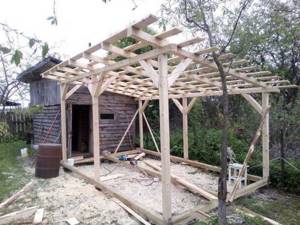
Installation of a finished structure or self-production of the frame requires a mandatory addition in the form of an awning.
After installing the frame, the next step is to tie it with durable awning material. The roof must be sheathed, and any of the walls is optional. Instead of one or more walls, a mosquito net can be installed, which will not only protect against insects, but also improve visibility outside the tent.
Other options
In addition to a tent with a pitched roof, you can make a simpler option, which is more appropriately called a gazebo-canopy. The design has 4 racks, a roof with four slopes and a table, which is located in the center of the gazebo. To construct this object, you need:
- boards for the table, supports and roof ties;
- wooden beam 10x10 meters, 3 meters long;
- wire;
- cement mortar;
- nails and screws.
Having decided on the site for the construction of a stationary tent, it is necessary to mark the site. A wooden beam treated with antiseptics, which will serve as a support, is dug in a vertical position to a depth of 60 centimeters, which is fixed to a pre-installed metal support. At the bottom of the wooden support, boards are fixed to act as ties. The top of the support pillar and the ends of the ties are fixed with rafters. To prevent the awning material from sagging under load, the gazebo roof structure should be additionally reinforced by installing wire between the rafters.
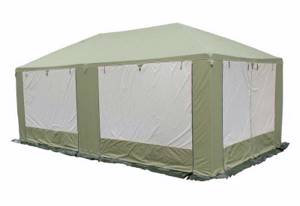
You can sew an awning for a gazebo from transparent or colored fabric, plain or with colors. Gazebos with an awning cover can withstand temperature fluctuations from -30° to +60°C.
Next, all that remains is to make a table according to the appropriate dimensions - determine its length, width, height and shape. Another option is a tent on a metal base, which you can also make yourself, without the help of professionals. As an option, you can make a gazebo with a bent metal profile, which will have an aesthetic arched shape. Accordingly, an awning, sewn to the planned dimensions, is stretched over the erected frame.
How to assemble a finished structure
Think carefully about the purposes for which the gazebo will be used and under what conditions. The correct selection of material will determine the service life of the fabric. Having decided on the material, you can begin to consider the installation diagram. A simplified assembly technology can be considered screw. When laying the center counterweight on the ground, there should be a thread in the middle for screwing on the tent. Therefore, there is a need to install a reliable awning structure. It is better to give preference to models with metal bases and brackets. The sequence of assembling the awning structure is as follows:
- A suitable location is determined. The durability and functionality of the tent depends on the location of the main structure, the tension angle and other small details.
- Prepare the area for the installation of a gazebo-tent. If the awning is not mounted directly on the ground, then install bases.
- Assemble the support posts.
- Adjust their alignment. Make sure the support legs are stable.
- Install the roof base.
- Make sure all frame elements are stable.
- Stretch the awning cover.
- Correctly adjust the angle tension and force. The effectiveness of the protective awning will depend on this.
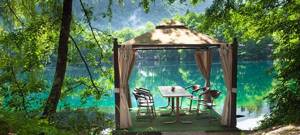
Don't forget about the assembly instructions for this object
Is it possible to sew an awning yourself?
An awning is installed on the manufactured frame of the gazebo, which you can sew with your own hands. To sew the canvas, you will need high-quality durable fabric - it can be tarpaulin or any similar material. In addition to the material, you need a sewing machine and sewing skills. However, it is worth understanding that PVC material is not suitable for making an awning, since the hot air welding method is used to connect its seams.
To produce a tent awning at home, you must complete the following steps:
- take measurements of the frame of the gazebo, according to which the awning will be sewn;
- make a pattern on thick cardboard, cut out the resulting parts and place them on the fabric;
- Having cut out the resulting parts from the fabric, you need to sew them in the correct order. You need to retreat 1-2 centimeters from the edges of each part - this margin is left for the seams. Without providing for such an indentation, the awning may simply not fit on the prepared frame;
- the edges of the awnings must be swept;
- the resulting seams are sealed from the inside with sealed tape, which prevents moisture from seeping through them;
- On the canvas, in increments of 0.5–1 meters, metal fasteners are installed - eyelets, through which slings are threaded for fixation on the frame of the gazebo.
Having completed the above steps, you will end up with a full-fledged tent gazebo, in which you can organize evening gatherings with loved ones. It protects from gusts of wind, scorching sun rays, and rain. Additionally, the tent can be equipped with a mosquito net, which will prevent the penetration of blood-sucking insects.
Assembling a fabric gazebo
Another option for manually assembling one of the gazebo options:
- Wooden beams with a cross section of 100–150 mm will be used. Prepare blanks 2.5 m long.
- Workpieces must be placed in each vertical support in the center and at the corners of each vertical support with a height of 2.1 m and a cross-section of 80 mm.
- At the tops of the posts, secure them with top straps.
- Secure the rafters.
- For the foundation for the tent, it is necessary to level the site. The foundation can be shallow strip or columnar.
- Make a recess of the required size using a brace.
- Place the supports and concrete them.
- One side of the supports should be 30 cm higher.
- Use rafters to secure the supports.
- Stuff the sheathing.
- Apply two or three layers of antiseptic to the tent frame.
The gazebo-tents presented in the article are good garden additions. They are more spacious than a regular tent, and they will perfectly decorate the design of the site. There is also an important plus for grill and barbecue lovers: if the height of the canopy is about 2 m, then you can put a barbecue under it.
Be sure to follow all fire safety precautions to avoid injuries and accidents.
PVC awning repair
Sooner or later, the gazebo begins to break down - one of its most vulnerable points is the awning, which wears out over time - stretches, breaks, wears out. As a result, a dilemma arises - buy a new canvas for the tent or repair the old one. Many, wanting to save money on purchasing a new awning, try to repair the old one. If a hole has formed on the awning, it can be patched using a patch. The patch is made from the same material as the main fabric. Additionally, a roller, glue, and a hair dryer are used.
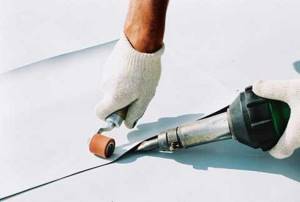
To fix holes in the awning, you should:
- align the edges of the punctured hole on the awning, cutting off all protruding rags;
- Wipe the damaged area with a wet and dry cloth;
- do the same manipulations with rags as with the base material with the patch;
- degrease the patch and damaged surface.
When working with a hair dryer, you need to do the following:
- install a patch on the damaged area of the PVC sheet and warm it thoroughly with hot air, which will ultimately lead to welding of the materials;
- the heated patch must be rolled with a roller, and the main fabric must be stretched to the sides;
- a load of several kilograms is placed at the junction for at least 1 hour;
- after the specified time has expired, the awning can be installed on the gazebo and continue to be used for its intended purpose.
Using another method, you should also clean the surfaces from dirt, degrease with acetone and apply an adhesive. The manufacturer recommends using a special glue for PVC surfaces called “Cosmofen” - it ensures strong fixation of the patch to the base material for a long time. When joining materials, you need to roll the patch with a roller and put a weight on it for several hours, then use it.
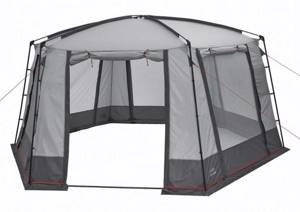
Types of gazebo tents that you can make yourself are practical and easy to use. In addition, they cost the owner less than those bought in a store - to make gazebos at home, you only need to spend money on buying building materials. Regardless of how the gazebo was made, it may differ from other models in shape, size, type of construction, color, availability of components and price. More details at tent-chehol.com Tailoring of awnings to order.
Tent protective treatment
The metal structure requires weather protection. Such protection can be carried out after the formation of the main frame.
- After the frame is mounted, it is completely disassembled and the metal elements of the structure are painted. To do this, you can find a place, cover it with polyethylene and start painting.
- First, you should sand the areas that have already begun to rust and coat them with a primer.
- After complete drying, metal structures can be painted with exterior paint. As a rule, this is a minimum of two layers.
- Painting must be done very carefully, especially for attachment points. In order for the painting to be of high quality, each layer should be allowed to dry completely.
Site preparation
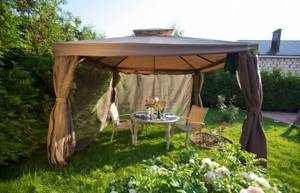
Garden awning.
Having chosen a tent design, fabric and other materials, prepare the area for the gazebo. If you are planning a portable tent-tent, then the soil does not need to be removed. If it is stationary, then we do the following.
Decide on the location - the gazebo should be on a flat, dry area. A stationary tent will require the construction of at least a light foundation, so we do this:
- the surface should be cleared of debris, stumps, grass, and it is better not only to remove stones, but also to remove the top layer of soil by about 10 cm;
- in this place you will have to make a fixed floor, so sand should be poured onto the soil removed from the ground and spilled with water.
How to cover a tent
It is worth saying right away that the tent is covered not for beauty (it is also impossible without it), but so that the covering performs protective functions. And you will have to protect yourself from wind, rain, and also from insects.
- Only thick fabric designed for such purposes can cope with its task.
- Regular fabric, curtains, organza are elements that can be used to decorate the interior space to create a certain coziness.
- To protect against midges and other insects, you can use special nets and special fabric, for example, tulle, from which you can sew a stylish covering that prevents insects from getting inside the tent. By using beautiful, modern tulle you can make your tent more attractive.
A gazebo tent is not a complicated structure, but it must be done with high quality. The most important thing is to make it stable and apply a high-quality coating. So, watch the video in this article and photos, select the desired option and you can start installing.
Selection of installation location
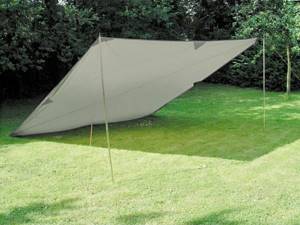
Even if a simple awning tent is installed on the site, it must fit into the overall picture of the landscape design of the site. This especially needs to be monitored if a permanent building is installed on the site. It is worth choosing in advance the place where the gazebo will later be installed.
If the landscape of the site is strewn with flowers, the tent will look very romantic. Most often, gazebos are installed in a large space, for example, on a green lawn. The building is also allowed to be placed next to the main building. The most important thing for setting up a tent is that it must be installed on a flat surface. The area should be free of weeds and plant roots; debris and stones must be removed.
For stationary tents you need to make a foundation and flooring. Paving slabs, as well as natural stones or wood cuts can be used as flooring. These devices will help increase the service life of the building.
A folding type of gazebo similar to a tent
Making a folding model yourself is not that difficult. The base is mounted on a wooden board, which is attached to a flat wooden surface. Triangular isosceles sidewalls made of tongue-and-groove boards 30-40 mm thick are used as load-bearing structures. Such a triangular system will increase the rigidity and stability of the structure. For stationary installation, the sidewalls are made solid.
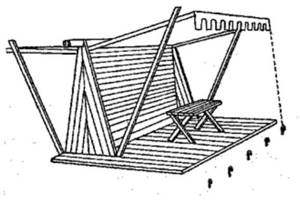
It is always better to make portable options collapsible, made of 2 sections, which quickly move from place to place. Each section consists of 2 sidewalls in the form of a right triangle. A lining is suitable for this. The elements are attached to ridge bars on piano hinges or window hinges. The ridge or top bar is inserted into additional cutouts on the sidewalls, and then firmly fixed with screws or nails. The sections also include vertical opening walls. During assembly, simple corners for furniture are attached to the halves of the gazebo; bolts are placed in their holes, which are secured with nuts. The sides are held in the open position by support bars, the lower ends resting on the sidewalls, and the upper ends resting on metal stops. You can make both or only one side panel rise.
A summerhouse pavilion in the form of a tent can be made according to different designs, but its durability is characterized by the quality of the awning and the reliability of the frame.
Advantages of a country tent
In order to build a gazebo at the dacha, you need to organize thorough construction on the site. A gazebo has significant disadvantages, but a garden awning has many advantages:
- it is light;
- low cost;
- simple assembly;
- It does not require special care;
- mobile;
- large coverage area;
- reliable shelter from wind, sun and insects;
- it is convenient to store, it folds;
- variety of colors;
- many options for textures and materials for construction.
All these advantages significantly exceed the construction of a gazebo.
Manufacturing technology
You can make a tent for outdoor recreation with your own hands using the following instructions.
- Clear and level the base for the future shelter.
- Drive (or dig) aluminum tubes or fiberglass reinforcement into the ground. Make sure the four supports that will hold the roof up are vertical. You can use a simple plumb line (a stone or a piece of stick on a string) - if you need to accurately align the supports vertically.
- Mark and drill holes in the upper ends of the supports for bolts securing the horizontal crossbars that strengthen the structure. They will not let it become loose from the wind. Secure them with bolts and nuts. To prevent the structure from weakening, press and groove washers are used on both sides of each connection.
- Stretch and tie the roofing material around the corners. It can serve as an awning. It must be waterproof - with water-repellent impregnation. It’s even better when the same material has an additional coating that protects it from destruction under the influence of solar ultraviolet radiation. In dry weather, you can use old sheets or duvet covers - when the tent is set up in tourist conditions (at a rest stop).
- Install additional guy wires . There should be as many of them as the main supports. To do this, drive steel pegs (they can be bent into the shape of the letter “L” from large, at least 20 cm, nails) into the ground. Tie string around the upper corners (where the horizontal supports attach to the vertical ones) of the structure, then pull it tight and tie it to the pegs. Check that the pegs are not loose and drive them deeper if necessary.
- Stretch the same material from the sides and attach it with twine to the vertical supports. The material will serve as the walls of the tent. If you take longer pieces of material, it is advisable to fix the lower edges to the ground with sticks and/or stones so that they do not flutter in the wind.
- Hang a mosquito net at the entrance. If necessary, it can be secured with clothespins - this will save tourists from mosquitoes, especially when spending the night in the forest, near a swamp, in a grove, near a river or lake.
This design resembles a tent-type tent. Ready-made prefabricated tents are equipped with all the necessary components - and are classified as camping (especially prefabricated) options. They are suitable for hiking, picnics, and for camping. The main thing is not to lose the fasteners (bolt kit, pegs). For subsequent assembly and disassembly you only need a couple of wrenches.
Arcs made from glass reinforcement are more flexible and resilient: fiberglass is not without reason used for tents in the lower and middle price ranges. The disadvantage of fiberglass is the use of clamps (you can use water pipes) and/or staples instead of bolts and nuts.
Horizontal arches should be secured only after vertical ones have been installed. In both cases you will get a collapsible tent.
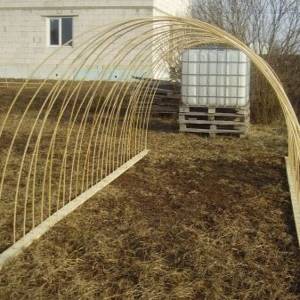
A more capital design - for a summer residence - provides a pre-prepared site. Covering – paving slabs, asphalt, concrete. The instructions for constructing such a tent are as follows.
- Drill holes in the asphalt (or concrete) for supporting supports and for guy pegs . In diameter they should be close to the tubes or fittings from which these supports are made. Paste them. It is not necessary to hammer in - concrete with a thickness of 10 cm will hold the shelter being built well.
- Assemble the tent according to the instructions above. The only difference is that not only the upper, but also the lower horizontal crossbars are needed. The pieces of fabric that serve as the walls of the tent are secured on all four sides. The roof and mosquito net are tensioned in the same way.
The disadvantage of homemade (and industrial) tents of all types is that they will not withstand hail. Any matter breaks through with hailstones the size of a walnut (or more).
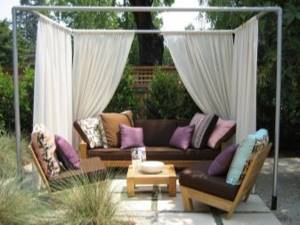
Waterproof fabric
Moisture-resistant and waterproof tents are used in areas where there are frequent changes in climatic and weather conditions.
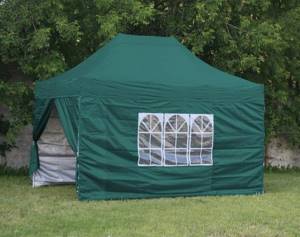
Such models help to completely protect a certain area of land from rain and retain the properties of protecting the covered area from the scorching sun, and protect people from insects and parasites.
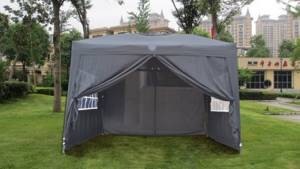
Types of structures
There are two types of tent configurations: with open and closed walls. The simplest type of tent is a dome, which is supported by four supports. It is best to use it in spring or autumn: at this time of year people are not bothered by insects, and the sun is not too hot. Most often it is placed near the barbecue or in a corner of the estate, which is protected from drafts.
Tents with closed walls provide the best protection from the heat. If you close the curtain, you can hide from the winds, sun and insects. Air circulates well inside, and the walls can be opened at any time if desired.
Depending on the material used, there are different types of awnings.
A wooden tent is environmentally friendly, multifunctional and, above all, cozy . Tents on a wooden frame are best suited for DIY construction, and this structure is also easy to disassemble. Therefore, it can be stored in a shed for the winter and will not be exposed to harsh weather conditions. It is very comfortable. You can install a stationary tent, but the folding model has more advantages: it can be installed in different places each time.
The best option for decorating a dacha is country style : tents with a brick frame are often equipped as a summer kitchen. You won’t need a lot of kitchen utensils here, and dining in the fresh air can become a good tradition for the family. You can also place a pub there for friendly gatherings: for this, a barbecue is installed inside the tent, and long benches next to it - and everything is ready.
You can also organize a party with a hookah in the tent; for this purpose, soft ottomans are placed there, and it will turn out to be a kind of cafe in an oriental style.
Due to the fact that a brick building is a permanent structure, a little work should be done on it. But the result will compensate for the time spent.
Metal frames are the safest and most durable. Building such a structure yourself can be a little problematic. Therefore, you need to take the help of a professional, be it a welder or a blacksmith. Such a place to relax will be strong and durable.
